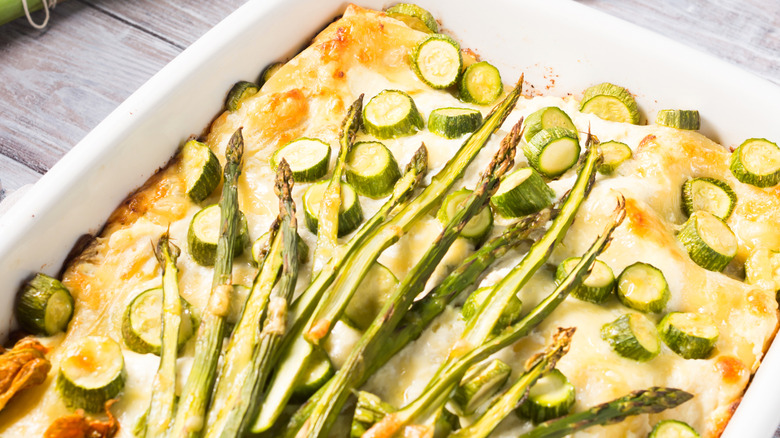The Delicious Way Giada De Laurentiis Adds Veggies To Lasagna
When the millions of followers that chef Giada De Laurentiis has garnered learns of one of her recipes, they trust that if they follow her tips and instructions, the dish will turn out to be just as delicious as it looks. Therefore, when the Italian American author and television host shared her recipe for including vegetables in lasagna, many wouldn't question her veggie of choice: asparagus.
De Laurentiis' decadent cheesy pasta casserole can be made gluten-free or with classic lasagna noodles. In it, she layers tender asparagus spears, creamy ricotta, and richly savory pancetta between the noodles, and it is topped with a sun-dried tomato and basil mix.
De Laurentiis boils the noodles until they are just firm, and since you should always pre-cook the veggies in vegetable lasagna to remove excess moisture, she sautés the asparagus until tender (about four minutes). Cooking the asparagus before layering it in the lasagna is an important step that prevents sogginess. However, it's also important to cook the spears just until tender-crisp and then let them rest, as they will add too much moisture if left to cook further. Finally, she simply bakes the casserole to a delicious finish.
Tips on making asparagus lasagna
When making asparagus lasagna, chef Giada De Laurentiis likes to intensify the flavor of the veggie before adding it to the casserole. For a delicious twist on the classic recipe, you could try roasting the asparagus before adding it to the layers, which will add a slight smokiness and lovely crispiness. When combined with the creamy ricotta (De Laurentiis chooses ricotta rather than béchamel as a lasagna filling in this recipe) and mozzarella cheeses, the asparagus will perfectly complement their flavors. Instead of using sun-dried tomatoes and basil, you could switch things up with fresh mint and lemon, or pesto and frozen peas — which Bobby Flay prefers to fresh.
If you have leftovers (that's a big if), wrap them tightly in plastic or foil, or store in an airtight container, and place in the fridge for up to five days. Storing the lasagna in the freezer can cause the casserole to become soggy when reheated, particularly due to the high moisture content of the asparagus and ricotta. Therefore, it's recommended to store it in the fridge only.
When you're ready to reheat the asparagus lasagna, place it in a 350-degree Fahrenheit oven, covered with foil to keep it moist, for about 20 minutes or until it's heated through. Although you'll achieve better results in the oven for larger quantities, you can microwave individual portions for a couple of minutes.

